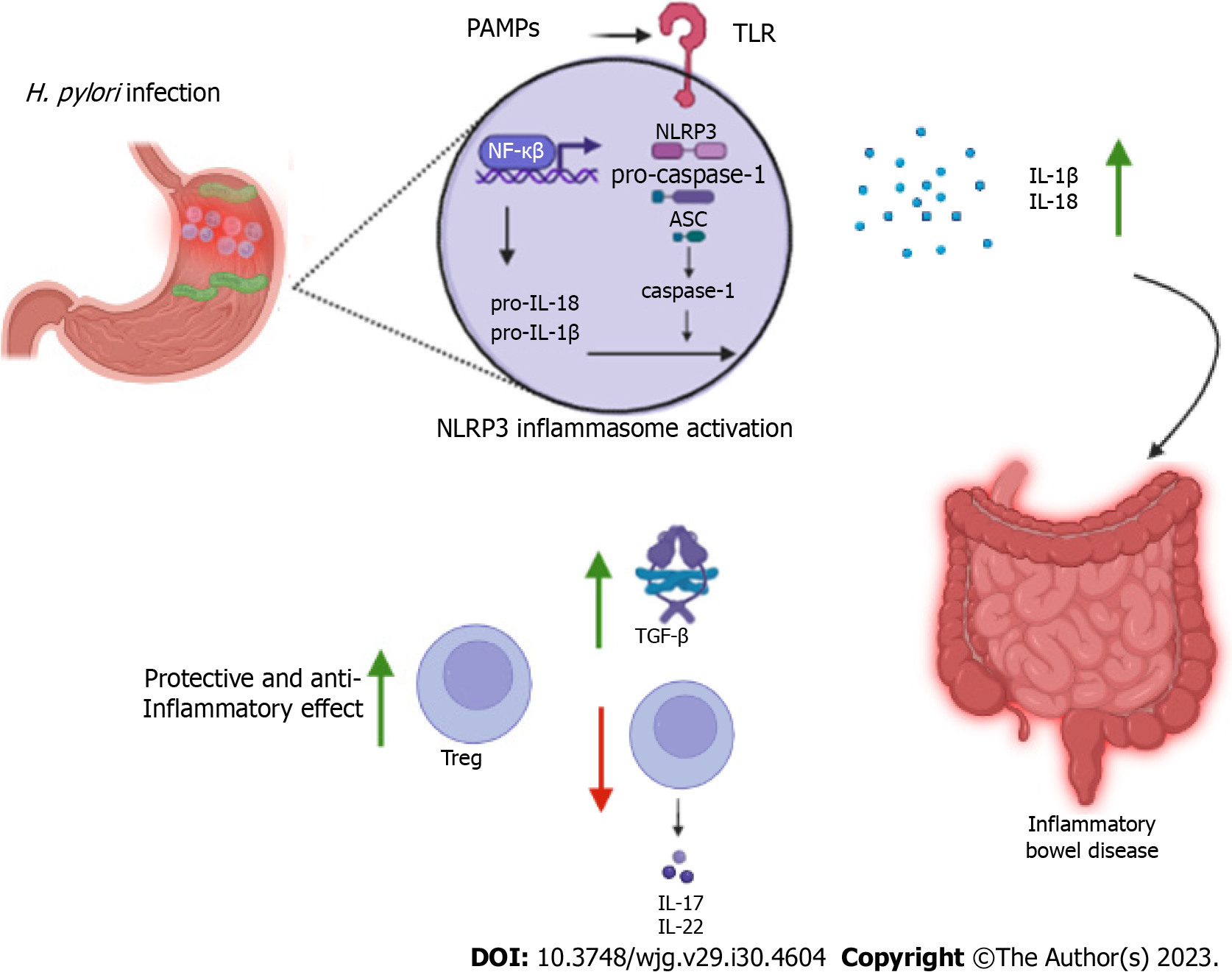Copyright
©The Author(s) 2023.
World J Gastroenterol. Aug 14, 2023; 29(30): 4604-4615
Published online Aug 14, 2023. doi: 10.3748/wjg.v29.i30.4604
Published online Aug 14, 2023. doi: 10.3748/wjg.v29.i30.4604
Figure 1 Mechanisms of Helicobacter pylori cytotoxin-associated antigen A+ on favorable prognosis of inflammatory bowel diseases.
The presence of the cytotoxin-associated antigen A gene at the Cag pathogenicity island induces the modulation of T helper 17/Treg immunological response (1), which reduces levels of interleukin (IL)-17F, IL-17A, and IL-21 and increases the expression of IL-13, IL-10, and Treg (2). These two factors are synergists in the conversion process of the M1 to M2 macrophage lineage (3). Then, M2 macrophages suppress signaling mediated by toll-like receptors (4) and activate metabolic pathways mediated by basic leucine zipper transcription factor ATF-like 2, increasing CD163, a macrophage/monocyte scavenger receptor (5). Finally, the levels of IL-10 expression also increase (6), leading to anti-inflammatory effects (7) and, therefore, to a better prognosis on inflammatory bowel diseases. H. pylori: Helicobacter pylori; IL: Interleukin; TLR: Toll-like receptor; IBD: Inflammatory bowel disease; CagA: Cytotoxin-associated antigen A; Treg: Regulatory T.
Figure 2 Immunomodulation of the NLR family pyrin domain containing 3 inflammasome and protection against inflammatory bowel diseases.
Pathogen-associated molecular patterns from Helicobacter pylori are recognized by the NLR family pyrin domain containing 3 (NLRP3) inflammasome toll-like receptors leading to responses that appear to be associated with improved prognosis and an anti-inflammatory effect. Activated NLRP3 is able to increase the expression of caspase-1 which activates the cytokines interleukin (IL)-18 and IL-1β. The positive regulation of these cytokines leads to extragastric immunomodulation by suppressing the T helper 17 subpopulation and increasing regulatory T, transforming growth factor-β and mucins. H. pylori: Helicobacter pylori; IL: Interleukin; PAMPs: Pathogen-associated molecular patterns; TLR: Toll-like receptor; TGF: Transforming growth factor; NLRP3: NLR family pyrin domain containing 3; Treg: Regulatory T.
Figure 3 Hypothesis on correlation between concomitant infection with Helicobacter pylori and the presence of ulcerative colitis (inflammatory bowel disease), which has a pathological pattern of exacerbated T helper 2 response.
The schematic shows HP-NAP being secreted into the gastric mucosa by Helicobacter pylori (H. pylori). Then, HP-NAP undergoes a process of transcytosis by endothelial cells, binding to the luminal side of the blood vessel. With this, there is an alteration in the expression of β-2-integrin, with the recruitment of neutrophils and monocytes, which carry out diapedesis. The recruited leukocytes secrete cytokines [interleukin (IL)-12 and IL-23], which promote a polarization of the circulating lymphocytes to a T helper 1 (Th1) pattern. The Th1 polarization causes a reduction in the Th2 response, this could explain the improvement of ulcerative colitis symptoms in patients infected with H. pylori. H. pylori: Helicobacter pylori; IL: Interleukin; Th: T helper; HP-NAP: Helicobacter pylori neutrophil-activating protein.
- Citation: Feilstrecker Balani G, dos Santos Cortez M, Picasky da Silveira Freitas JE, Freire de Melo F, Zarpelon-Schutz AC, Teixeira KN. Immune response modulation in inflammatory bowel diseases by Helicobacter pylori infection. World J Gastroenterol 2023; 29(30): 4604-4615
- URL: https://www.wjgnet.com/1007-9327/full/v29/i30/4604.htm
- DOI: https://dx.doi.org/10.3748/wjg.v29.i30.4604











